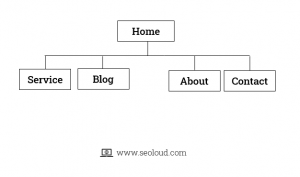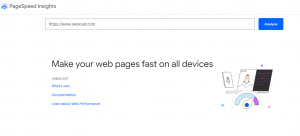Maximize SEO Impact – Optimize Your Website Structure
Creating a website without a well-defined structure can cause issues for both users and search engines. If you want to make sure your website is easy for both users and search engines to navigate, the key is to focus on creating a simple and intuitive user interface.
It is essential to conduct thorough research specific to your business niche. Look for websites that are known for their exceptional design and user-friendly features, and take the time to explore them.
By learning from these top-performing websites, you can know valuable insights and inspiration for creating a structure that meets the needs of your audience. This approach will not only improve user experience but also increase your website’s visibility in search engine rankings.
Let’s take a moment to consider these three essential factors:
- Competitor Research: Take a deep dive into your top competitors’ websites. Explore their website structures and layouts.
- Page Loading Speed: Another critical aspect to assess is the loading speed of their web pages. A faster website provides a better user experience.
- Silo and Interlink Analysis: Lastly, hunt into their contents. Understand how they have structured their content using silos and interlinking strategies.
Website structure: What’s it like?
The way a website is designed and arranged is called site structure. This includes how contents are categorized, and inter-linked together, creating a hierarchy that determines how users navigate the site.
Elements of site structure include menus, headers, sub-headers, categories, internal links, page speed and contents layout. It is essential in making sure a website is easy to use, accessible, and ranks well in search engine results, which can affect its overall success.
Why is site structure important?
When it comes to web development, the structure of a website is incredibly important. It plays a crucial role in making information and products easily accessible to users and search engines.
A well-structured website provides a seamless and user-friendly navigation experience, which enhances user satisfaction, increases engagement, and contributes to the organic traffics of the website.
In addition, search engines rely on a website’s structure to effectively index and crawl its contents. Optimized websites are more easily understood by search engine algorithms, which results in improved search engine rankings.
Steps to Crafting a Website Structure for SEO
1. Website Navigation
Navigation plays a pivotal role in determining a website’s traffic, conversion rate, and search engine ranking. According to the “The 59 Seconds Rule” of Cody Ray Miller – there are 3 reasons to users for leaving a website:
- Inability to Find Information: Users exit a website when they cannot locate the information or products they require.
- Complex Website Structure: Confusing or convoluted website structures can lead to user frustration and prompt them to seek alternatives.
- Providing False Information: When a website presents inaccurate or misleading information, users are inclined to move on to more reliable sources.

It significantly influences the user experience. Effective navigation empowers you to control your website’s performance, maintain a favorable bounce rate (ideally below 60%), and guide your audience seamlessly through your web pages.
To create an exceptional website navigation experience, consider the following key points:
- Define Website’s Primary Categories
- Subdivide Categories as Needed
- Implement User-Friendly Search Features
- Utilize ALT Tags for Images
- Ensure Content Relevance
- Create Clickable Navigation Links
2. URL Structure SEO
URLs appear in search engine results. The appropriate URL structure for a website represents a crucial element of SEO. Prominent search engines such as Google tend to assign higher rankings to URLs that are user-friendly, concise, and convey descriptive information.
Among 200 SEO ranking factors, the URL is one of the most important elements. That’s why it’s essential to put in the effort to optimize your URL structure. Creating an SEO-friendly URL structure doesn’t have to be overwhelming. If you use WordPress, there’s a simple method available to manage and improve your website’s URL structure.
However, the final stages are not complete until you have considered the following factors to ensure a website structure that is both intuitive and user-friendly.
- Utilize HTTPS for optimal security.
- Mention relevant keyword within the URL.
- Avoid keyword repetition.
- Maintain a concise URL, According to the advice of Matt Cutts (3-5 words).
- Ensure readability for both humans and search engines.
- Keep the URL length of 50-60 characters.
- Align the URL with the content’s relevance.
- Avoid the use of stop words based on a predefined list.
- Don’t keyword stuffing in URL.
- Use hyphens instead of underscores in URLs.
Here are some recommend ways:
Small website or blog:
http://www.example.com/your-keyword-title-topicA large website with many categories posts:
http://www.example.com/category/your-keywordNot recommend:
http://www.example.com/use-irrelevant-wordshttp://www.example.com/make-it-long-too-long-for-mentioning-keywords3. Internal Linking Structure
An internal link, in essence, connects one webpage to another within the same domain. It helps user navigation, stay engaged on a page, and reduces bounce rates while improving search engine rankings.
Internal linking structure offers various advantages, such as the transfer of authority between posts and pages; the potential to boost sales and conversion rates.
A well-planned internal linking strategy, which may include a silo structure, is crucial for effective content marketing. It provides clear direction to your targeted audience, making it easy for them to find content or products.
Example of link structure:
<a href="http://www.example.com">anchor text</a>Why establish an internal linking structure?
- Facilitate user exploration of related content.
- Maximize search engine indexing.
- Efficiently distribute link juice equity across content pages.
- Prioritize on valuable content resources.
- Elevate website design and user experience.
4. Mobile Responsive Design
Mobile responsive design is an integral aspect nowadays. To drive mobile search traffic, ensure your website is user-friendly on mobile devices
Mobile responsive is a ranking factor.
According to SEO Ranking Factors
Even Google can penalize your website from mobile searches if you don’t optimize your website for mobile. As we know, mobile users are increasing constantly. Smartphone users in the world are expected to reach 2.7 billion by 2019. (Source: Statista)
Factors to consider for mobile responsiveness include:
- Supporting website navigation on various devices.
- Automatic adjusting of screen layout and website content for mobile devices.
- use easily readable fonts with a suitable text size, so users don’t have to zoom in.
In 2015, Google reported that mobile searches surpassed desktop searches.
“More Google searches take place on mobile devices than on computers in 10 countries including the US and Japan.”
According to Google
5. A Cool User-Friendly Design
Web design is an art that plays a crucial role in shaping a brand’s first impression on the audience.
“The first impression is 94% design related. Quality web design establishes trust and credibility.”
Seekbrevity
When it comes to content marketing, simply creating successful content is not enough. It’s important to also carefully plan how that content will be presented to your audience.
A well-crafted design can serve as the driving force behind your communication and leave a lasting impact.. Neglecting this aspect could cause your efforts to get stuck in the sales funnel.
What key factors may have been overlooked after reviewing this post? I will explore these factors further and provide insights below.
- Ensure fonts and typography are both visually appealing and highly legible.
- Choose an appropriate color palette.
- Create a user-friendly website layout.
- Rectify any coding errors.
- Fix W3 Validation issues.
- Fix broken hyperlinks.
- Avoid Flash contents and iframe.
6. Speeding Up Your Website
Website page loading speed is a ranking factor, officially acknowledged by Google for desktop searches since 2010 and for mobile searches since 2018.

To achieve a high conversion rate, your website must maintain an optimal loading speed. Faster page loading enhances user experience. Improving website speed? Here are some key things to consider.
- Optimize image dimensions for reduced file sizes.
- Employ code minification techniques.
- Optimize server response times.
- Select an appropriate hosting provider.
- Implement a Content Delivery Network (CDN).
- Enable lazy loading for improved performance.
- Minimize URL redirections.
- Monitor and enhance mobile loading speed.
- Activate browser caching for improved performance.
“79% of online shoppers say they won’t go back to a website if they’ve had trouble with load speed.”
Neil Patel
Certainly, here are the points highlighting the significance of a website’s loading speed for a business:
- Enhancing User Experience
- Improving Search Engine Rankings
- Boosting Conversion Rates
Have you heard about Amazon’s website speed research report? “They found that 1 second slow loading could cost 1.6 billion in sales each year.“
“Google will reduce the number of crawlers it sends to your site if your server is slower than 2 seconds.”
Google Search Central Blog
In the circumstances, the importance of website speed optimization is undeniable. It greatly impacts user experience, bounce rates, search engine rankings, and ultimately, sales performance.
Wrapping Up
Optimizing a website is a continuous effort that requires identifying and fixing many small issues. It involves constant analysis and improvement of all aspects of site optimization.
These six factors are closely related to on-site SEO and greatly enhance the chances of achieving a high position in search results after website optimization.

